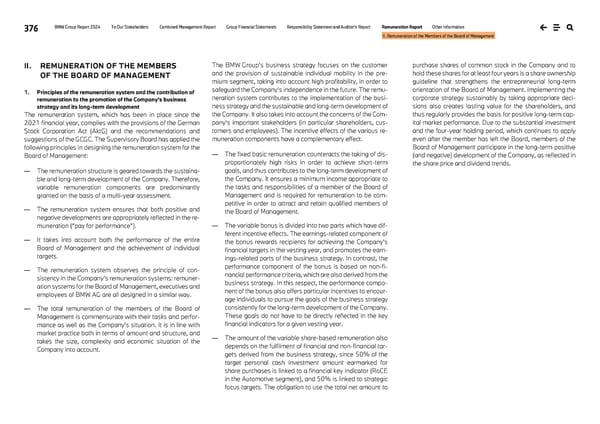376 BMW Group Report 2024 To Our Stakeholders Combined Management Report Group Financial Statements Responsibility Statement and Auditor’s Report Remuneration Report Other Information II. Remuneration of the Members of the Board of Management II. REMUNERATION OF THE MEMBERS OF THE BOARD OF MANAGEMENT 1. Principles of the remuneration system and the contribution of remuneration to the promotion of the Company’s business strategy and its long-term development The remuneration system, which has been in place since the 2021 financial year, complies with the provisions of the German Stock Corporation Act (AktG) and the recommendations and suggestions of the GCGC. The Supervisory Board has applied the following principles in designing the remuneration system for the Board of Management: — The remuneration structure is geared towards the sustaina- ble and long-term development of the Company. Therefore, variable remuneration components are predominantly granted on the basis of a multi-year assessment. — The remuneration system ensures that both positive and negative developments are appropriately reflected in the re- muneration (“pay for performance”). — It takes into account both the performance of the entire Board of Management and the achievement of individual targets. — The remuneration system observes the principle of con- sistency in the Company’s remuneration systems: remuner- ation systems for the Board of Management, executives and employees of BMW AG are all designed in a similar way. — The total remuneration of the members of the Board of Management is commensurate with their tasks and perfor- mance as well as the Company’s situation. It is in line with market practice both in terms of amount and structure, and takes the size, complexity and economic situation of the Company into account. The BMW Group’s business strategy focuses on the customer and the provision of sustainable individual mobility in the pre- mium segment, taking into account high profitability, in order to safeguard the Company’s independence in the future. The remu- neration system contributes to the implementation of the busi- ness strategy and the sustainable and long-term development of the Company. It also takes into account the concerns of the Com- pany’s important stakeholders (in particular shareholders, cus- tomers and employees). The incentive effects of the various re- muneration components have a complementary effect. — The fixed basic remuneration counteracts the taking of dis- proportionately high risks in order to achieve short-term goals, and thus contributes to the long-term development of the Company. It ensures a minimum income appropriate to the tasks and responsibilities of a member of the Board of Management and is required for remuneration to be com- petitive in order to attract and retain qualified members of the Board of Management. — The variable bonus is divided into two parts which have dif- ferent incentive effects. The earnings-related component of the bonus rewards recipients for achieving the Company’s financial targets in the vesting year, and promotes the earn- ings-related parts of the business strategy. In contrast, the performance component of the bonus is based on non-fi- nancial performance criteria, which are also derived from the business strategy. In this respect, the performance compo- nent of the bonus also offers particular incentives to encour- age individuals to pursue the goals of the business strategy consistently for the long-term development of the Company. These goals do not have to be directly reflected in the key financial indicators for a given vesting year. — The amount of the variable share-based remuneration also depends on the fulfilment of financial and non-financial tar- gets derived from the business strategy, since 50% of the target personal cash investment amount earmarked for share purchases is linked to a financial key indicator (RoCE in the Automotive segment), and 50% is linked to strategic focus targets. The obligation to use the total net amount to purchase shares of common stock in the Company and to hold these shares for at least four years is a share ownership guideline that strengthens the entrepreneurial long-term orientation of the Board of Management. Implementing the corporate strategy sustainably by taking appropriate deci- sions also creates lasting value for the shareholders, and thus regularly provides the basis for positive long-term cap- ital market performance. Due to the substantial investment and the four-year holding period, which continues to apply even after the member has left the Board, members of the Board of Management participate in the long-term positive (and negative) development of the Company, as reflected in the share price and dividend trends.
 BMW Group Report 2024 Page 375 Page 377
BMW Group Report 2024 Page 375 Page 377